-

人教版新目标初中英语八年级上册Could you please clean your room教案3篇
一、 教学内容Section A 1a----1c二、 教学目标1.学习词汇do the dishes, make the bed, take out the trash, fold the clothes, do the laundry, sweep the floor, clean the living room.2.句型 Could you please clean your room? Yes, sure.三、 教学准备 学生预习本单元所有的词汇多媒体课件 活动表 奖品四、 教学过程Pre-task1. Warming upEnjoy ourselves. Watch cartoon Cinderella. 看动画片段《灰姑娘》导如入本课话题和新词汇“chores”美丽善良的鬼姑娘因继母的嫉妒,每天得做所有的家务。片段的主题使学生联想到本课的话题。2. learn new words and phrasesLook! What is she / he dong? 看图学习动词词组do chores, do the dishes, make the bed, take out the trash, fold the clothes, do the laundry, clean the living room.3. Guessing game.What is she doing ? 4. Pair work. 1a, Do you do these things at home? Write “Y” for “yes” and “N” for “no”.5. Listening . 1b , Peter’s chores or Mom’s chores?理解目标语Could you please clean your room? Yes, sure.Write “M” for Mom’s chores, “P” for Peter’s chores in the chart.6. PairworkLook at the picture,Ask your partner to do the chores that you see. 7. Interview Who is the most able at home? 1) What chores do you do at home? How often do you do the chores? Work in four, interview each of the students in the group, fill in the chart.
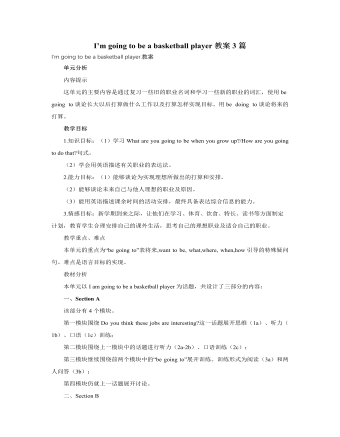
人教版新目标初中英语八年级上册I’m going to be a basketball player教案3篇
教学目标1.知识目标:(1)学习What are you going to be when you grow up?/How are you going to do that?句式。(2)学会用英语描述有关职业的表达法。2.能力目标:(1)能够谈论为实现理想所做出的打算和安排。(2)能够谈论未来自己与他人理想的职业及原因。(3)能用英语描述课余时间的活动安排,最终具备表达综合信息的能力。3.情感目标:新学期到来之际,让他们在学习、体育、饮食、特长、读书等方面制定计划,教育学生合理安排自己的课外生活,思考自己的理想职业及适合自己的职业。教学重点、难点本单元的重点为“be going to”表将来,want to be, what,where, when,how引导的特殊疑问句。难点是语言目标的实现。教材分析本单元以I am going to be a basketball player为话题,共设计了三部分的内容:一、Section A该部分有4个模块。第一模块围绕Do you think these jobs are interesting?这一话题展开思维(1a)、听力(1b)、口语(1c)训练;
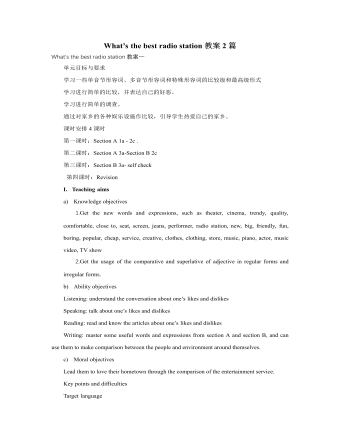
人教版新目标初中英语八年级上册What’s the best radio station教案2篇
教学重点和难点:运用所掌握的语言描述,比较不同地点的特点。在练习中学习掌握英语比较级和最高级的用法。课前准备分配小组,每组五至六人。通过上网或翻阅报刊杂志等方法,确定旅游线路,做出基本的旅游计划。教学设计:本节课流程图 学法指导:1.由于这是一堂新课,在教学中应注意面向全体,发挥学生的主体性,引导学生积极参与,激发学生的求知欲和学习积极性,指导学生积极思维,主动获取知识,养成良好的学习方法。逐步学会独立解决问题。总之要尽可能调动学生的非智力因素促进智力因素的发展。教法选择:1.电化教学法2.课堂讨论法3.任务型教学法采用这些方法的目的是为了充分调动学生的学习积极性,使学生变被动学习为主动学习。通过电脑形象的演示,加强印象,提高兴趣,突破难点,提高教学效率,进而增大教学的容量和信息量。充分体现教师为主导,学生为主体的教学原则。

人教版新目标初中英语八年级上册How do you get to school教案2篇
Step Ⅶ Role play ( Work on 1b)1. First ask two students to read the dialogue to the class.Sa: How do you get to school?Sb: Well, I ride my bike to the subway station. Then I take the subway.2. Now work with a partner.Suppose you use two kinds of transportation to get to school \Hangzhou\Beijing... (bus, train, subway, walking, bike, etc.) Tell how you get there. You may use the phrases in 1a.3. Then ask different pairs of students to present their conversations to the class.Step ⅧListening1. Work on 2a(1) First ask students to read the list of information that Thomas wants to know.…where Nina lives.…how far from school she lives.…how long it takes to get to school.…how she gets to school.…what she thinks of the transportation.(2) Tell students what transportation and bus stop mean.bus stop 汽车站 transportation n. 运送;运输Then tell students we'll hear a recording. Please put a checkmark in front of each thing that Thomas wants to know.(3) Now play the recording for students.( Have students pay attention to the sample answer.) (4) Then correct the answers.
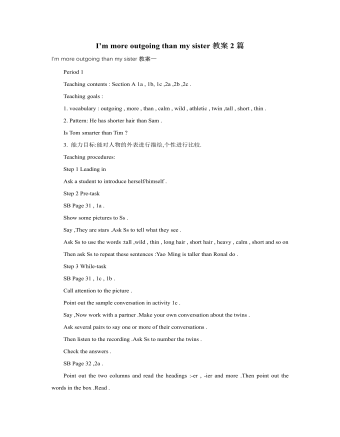
人教版新目标初中英语八年级上册I’m more outgoing than my sister教案2篇
1 交通工具的比较此活动为小组活动。学生通过讨论找出到达某一城市可乘坐的各种交通工具,并选择最佳出行方式。Teacher:We’re going to Shanghai. How many ways can we use to get there? Yes, there are four ways: by bus, by plane, by train, by ship. Please discuss how you are going to get there.操作建议:(1)学生以小组为单位展开活动,谈论本组所选择的交通工具。(2)各组选代表向全班汇报,阐述本组所选择的交通工具的利和弊。完成任务所需要的语言结构:We can go there by ship. It’s more comfortable and cheaper than any other transportation.We can go there by bus. It’s cheaper but it takes longer time.2 哪个城市更合适?此活动具有挑战性。假设中国要举行2014年世界杯足球赛,分别从历史,人文,天气等方面对各城市(北京,大连,上海,昆明)进行比较,选择最佳举办城市。T: Imagine China is holding the 2014 FIFA World Cup. Which city do you think is the best for the World Cup, Beijing, Dalian, Shanghai or Kunming? Let’s work in groups. If you choose Beijing, please join the Team Red. If you chose Dalian, please join the Team White. If you choose Shanghai, please join the Team Blue. If you choose Kunming, please join the Team Green. Please show us its advantages. Then let’s see which team will win.
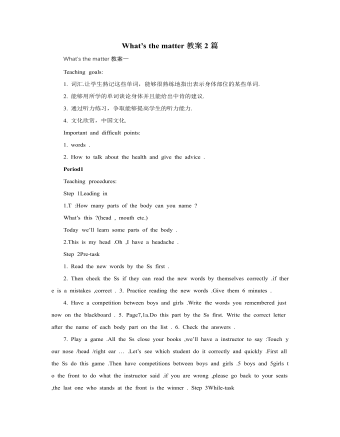
人教版新目标初中英语八年级上册What’s the matter教案2篇
She shouldn’t go to the party tonight.Step7. TaskT: You know, there are lots of problems in our life. If you are a doctor, please tell us how to solve the problem. I will divide you into 9 groups. Please work in groups. And then choose one of you to report your ideas.The following are the problems:I have a toothache.I am hungry. I have a sore throat.I am stressed out. I have a sore back.I am tired. I can’t sleep.I have a cold. I have a headache.Report: If you have a headache, you should go to bed early. You should see the doctor. You should eat some medicine. You shouldn’t wash your face with cold water.You shouldn’t sleep late.You shouldn’t swim.…..T encourages the students to give advice as much as possible.Homework:1. Chose one of the problems, and write down your advice2. Copy the new words这一步是用于热身的,同时也可以让他们复习一部分的表示人体部位的单词,扩充知识.学习语言的过程也是一个不断积累的过程,复习旧知识,增添新知识.通过小游戏,强化学生对Does she/he have…这个句子的运用能力.通过复习,自然的引到下面新知识的学习。充分利用表格,由句子到对话,再到文章,让学生循序渐进. 提高学生的综合语言运用能力,运用以前学过的知识来解决身边的问题.Period 5 (Section B 3a—3c, selfcheck)教学内容与分析:
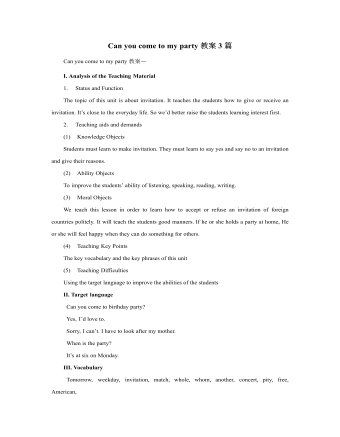
人教版新目标初中英语八年级上册Can you come to my party教案3篇
Step 3 (3b)First, tell the students when we talk about our future plans, we often use: I’m+verb+ing When we talk about what we must do, we use have to. Ask the students to fill in the blanks in 3b. The answers are: shopping, go to see, a test, I’m going, my family. Step 4 (3c)Let the students write an e-mail message to a friend. Say why you can’t visit next. Before the exercise, ask the students to give some possible answers and write them on the blackboard. So the students will feel easy to finish the writing exercise. After they finish it, Let them to correct it in groups first. Each group chooses theirs best one to read in front of the whole class. Step 5 ( planning a party )First read the conversation in the box together. Then ask the students to turn to page 88.Write down everything you have to do next week. Write in all the things you have to do . Ask the students to look at the list. Ask them “What day are you free?” This is when you can have your party. Step 6 (Self check 1 )Let the students to fill in the blanks with the words given. Change the forms of the words if possible. Then make their own sentences. The answers are: visit, playing, have to, study, comeStep 7 (Self check 2)Imagine you are Marie. Read the information and look at your schedule. Write replies to the invitation.
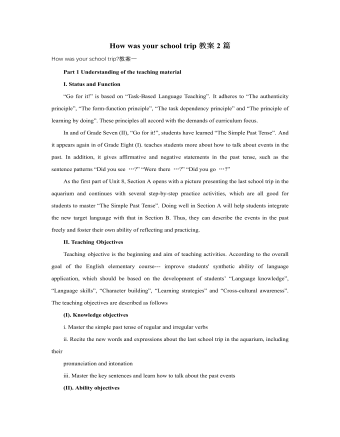
人教版新目标初中英语八年级上册How was your school trip教案2篇
“Go for it!” is based on “Task-Based Language Teaching”. It adheres to “The authenticity principle”, “The form-function principle”, “The task dependency principle” and “The principle of learning by doing”. These principles all accord with the demands of curriculum focus.In and of Grade Seven (II), “Go for it!”, students have learned “The Simple Past Tense”. And it appears again in of Grade Eight (I). teaches students more about how to talk about events in the past. In addition, it gives affirmative and negative statements in the past tense, such as the sentence patterns “Did you see …?” “Were there …?” “Did you go …?” As the first part of Unit 8, Section A opens with a picture presenting the last school trip in the aquarium and continues with several step-by-step practice activities, which are all good for students to master “The Simple Past Tense”. Doing well in Section A will help students integrate the new target language with that in Section B. Thus, they can describe the events in the past freely and foster their own ability of reflecting and practicing. II. Teaching ObjectivesTeaching objective is the beginning and aim of teaching activities. According to the overall goal of the English elementary course--- improve students' synthetic ability of language application, which should be based on the development of students’ “Language knowledge”, “Language skills”, “Character building”, “Learning strategies” and “Cross-cultural awareness”. The teaching objectives are described as follows(I). Knowledge objectivesi. Master the simple past tense of regular and irregular verbsii. Recite the new words and expressions about the last school trip in the aquarium, including their pronunciation and intonation
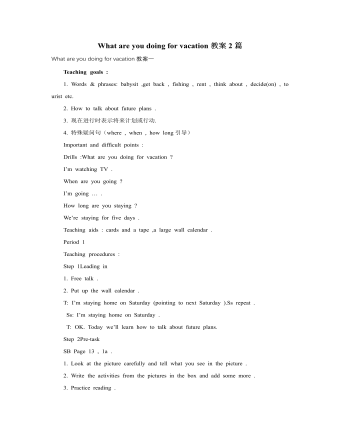
人教版新目标初中英语八年级上册What are you doing for vacation教案2篇
Teaching goals : 1. Words & phrases: babysit ,get back , fishing , rent , think about , decide(on) , tourist etc. 2. How to talk about future plans . 3. 现在进行时表示将来计划或行动. 4. 特殊疑问句(where , when , how long引导) Important and difficult points : Drills :What are you doing for vacation ? I’m watching TV . When are you going ? I’m going … . How long are you staying ? We’re staying for five days . Teaching aids : cards and a tape ,a large wall calendar . Period 1 Teaching procedures : Step 1Leading in1. Free talk . 2. Put up the wall calendar . T: I’m staying home on Saturday (pointing to next Saturday ).Ss repeat . Ss: I’m staying home on Saturday . T: OK. Today we’ll learn how to talk about future plans. Step 2Pre-task SB Page 13 , 1a . 1. Look at the picture carefully and tell what you see in the picture . 2. Write the activities from the pictures in the box and add some more . 3. Practice reading . Step 3While-task1. Using the activities we write in 1a to make conversations .For example :What are you doing for vacation ? I’m visiting my uncle . 2. Pairwork .Practice in pairs . 3. 用第三人称练习对话.
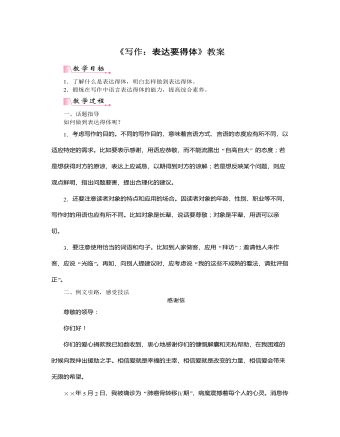
部编版语文八年级上册《写作:表达要得体》教案
(5)在右下方写提出倡议的单位名称或个人姓名,在名称或姓名下写日期。本次写作关键是正文部分,应先写清环境保护倡议活动的原因和现实背景,再写发出倡议的具体措施。最后总结一下,表明倡议活动的意义及倡议者的希望等。四、参考范文环境保护倡议书尊敬的领导、老师,亲爱的同学们:你们好!蓝天碧水、明媚阳光、鸟语花香、清新空气是构成我们梦寐以求的优美家园不可或缺的自然条件,但是废气、污水、白色垃圾、重金属等污染物侵蚀了这一切,环境污染已危及人类的健康与生存。有谁会想到,那些泛着刺眼的白色的饭盒会污染多少土地?有谁会想到,那些废弃的塑料袋随风飘散在空中,会污染多少城市和乡村?保护家园,就是保护我们自己;热爱家园,就是热爱生命。我们要用爱心去关注环境的变化,用热情去传播环保的观念,用行动肩负起环保的重任。
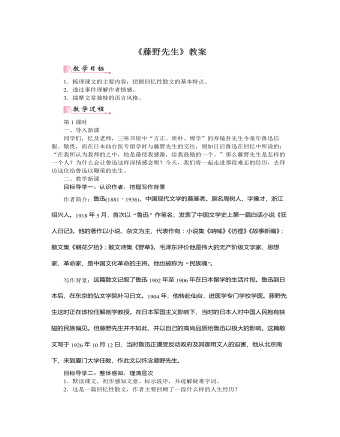
部编版语文八年级上册《藤野先生》教案
1.藤野先生有这么多优秀品质,对“我”如此关心,按理“我”应该留在仙台继续学医,可后来为什么改变了学医的志向呢?明确:当看到日本学生的狂妄傲慢(匿名信事件),尤其看到中国国民的愚昧麻木的时候(看电影事件),“我”的思想受到了严重挫伤。医术再高,只能医病,不能医治人心。要救中华民族,首先要救治国人的精神,唤醒国人愚昧、麻木的灵魂,而文学可以做到这一点。于是决定弃医从文,改变志向。材料链接:这一学年没有完毕,我已经到了东京了,因为从那一回以后,我便觉得医学并非一件紧要事,凡是愚弱的国民,即使体格如何健全,如何茁壮,也只能做毫无意义的示众的材料和看客,病死多少是不必以为不幸的。所以我们的第一要著,是在改变他们的精神,而善于改变精神的是,我那时以为当然要推文艺,于是想提倡文艺运动了。
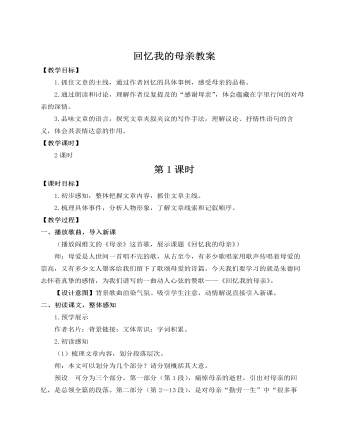
人教部编版语文八年级上册回忆我的母亲教案
提起了母亲,朱德将军满脸温情和悲痛。生他的时候,母亲不过二十刚过的年龄。她比一般妇女要高大一些,强壮一些,裤子和短褂上,左一块右一块都是补丁,两只手上突显着粗粗的血管,由于操劳过度,面色已是黝黑,蓬蓬的头发在后颈上挽成一个发髻,两只大大的褐色眼睛里充满了贤惠,充满了忧愁。(摘自史沫特莱《伟大的道路》)毛泽东写给朱德母亲的挽联毛泽东曾给朱德的母亲写了一副挽联:“为母当学民族英雄贤母,斯人无愧劳动阶级完人。”毛泽东在这副挽联中高度赞扬了朱德母亲的高尚品质,高度评价了他的革命战友朱德的革命精神。上联,“为母”是指做母亲。是的,母亲是儿女的第一任老师。那么,怎样才能做一个合格的母亲呢?毛泽东接下来告诉人们“当学民族英雄贤母”,告诉天下所有做母亲的人,要学习民族英雄——朱德贤惠的母亲。上联的重点在于赞子,既悼母又赞子,一语双关。
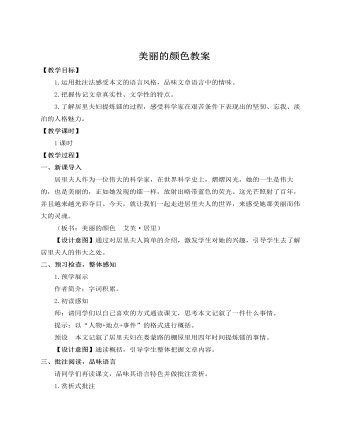
人教部编版语文八年级上册美丽的颜色教案
五、高山仰止,景行行止资料助读1:课件出示:居里夫人长期在没有防护措施的恶劣条件下进行科学研究,长期接触放射性物质,致使有害物质严重危害了她的身体健康,最终得了恶性贫血白血病。镭射线在无声地侵蚀着居里夫人的肌体,她美丽而健康的容貌在悄悄消逝,逐渐变得眼花耳鸣,全身无力。师:重病中的居里夫人,在你们心中、在人们心中还美丽吗?资料助读2:我对她的人格的伟大愈来愈感到钦佩。她的坚强,她的意志的纯洁,她的律己之严,她的客观,她的公正不阿的判断——所有这一切都难得地集中在一个人的身上。——爱因斯坦《悼念玛丽·居里》师小结:镭有美丽的颜色,居里夫人的人格、精神更是具有美丽的颜色,而且这种美将是永恒的!希望你们永远记住美丽的居里夫人,永远记住居里夫人美好而崇高的人格!【设计意图】资料助读+追问,将学生对人物精神品质的理解引向了更深的层次。
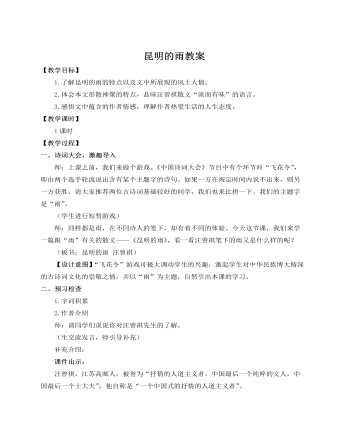
人教部编版语文八年级上册昆明的雨教案
1.我写散文,是搂草打兔子——捎带脚。不过我以为写任何形式的文字,都得首先把散文写好。2.我是希望把散文写得平淡一点,自然一点,家常一点的。3.我想把生活中真实的东西、美好的东西、人的美、人的诗意告诉人们,使人们的心灵得到滋润,增强对生活的信心、信念。4.我希望我的作品能有益于世道人心,我希望使人的感情得到滋润,让人觉得生活是美好的,人是美的,有诗意的。你很辛苦,很累了,那么坐下来歇一会,喝一杯不凉不烫的清茶,读一点我的作品。5.使用语言,譬如揉面。面要揉到了,才软熟,筋道,有劲儿。水和面粉本来是两不相干的,多揉揉,水和面的分子就发生了变化。写作也是这样,下笔之前,要把语言在手里反复团弄。疑难突破深度体会《昆明的雨》中情之绚烂有些描写不合常情。比如“我不记得昆明的雨季有多长,从几月到几月,好像是相当长的。但是并不使人厌烦”,从常理看,长长的雨季是会让人感到憋闷不舒适的,而作者却觉得“并不使人厌烦”。由此,可体会“我”对昆明雨季的一份特别的爱。
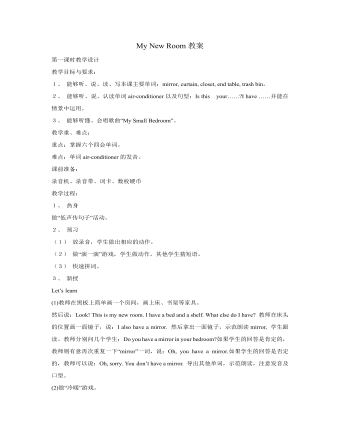
人教版新课标PEP小学英语五年级上册My New Room教案
Let’s learn(1)教师在黑板上简单画一个房间,画上床、书架等家具。然后说:Look! This is my new room. I have a bed and a shelf. What else do I have? 教师在床头的位置画一面镜子,说:I also have a mirror. 然后拿出一面镜子,示范朗读mirror, 学生跟读。教师分别问几个学生:Do you have a mirror in your bedroom?如果学生的回答是肯定的,教师则有意再次重复一下“mirror”一词,说:Oh, you have a mirror.如果学生的回答是否定的,教师可以说:Oh, sorry. You don’t have a mirror. 导出其他单词,示范朗读,注意发音及口型。(2)做“冷暖”游戏。(3)教师在黑板上示范书写单词:mirror, curtain, closet, end table, trash bin,让学生在词卡反面或练习本上拼写、记忆单词。(4)播放本课录音,让学生在书上手指相应单词并跟读。巩固延伸:做句型接龙游戏;做“找同伴”活动;学唱歌曲;完成配套练习;练习书写单词第二课时教学设计教学目标与要求:1、 能够听懂、会说本课对话,并能做替换练习。2、 能够听、说、认读句型There is a ……/There are …并能在情景中正确运用。3、 了解Good to know内容。
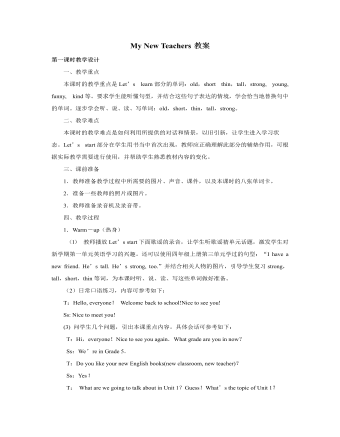
人教版新课标PEP小学英语五年级上册My New Teachers教案
教师播放Let’s learn课件,提问:Guess, what does Wu Yifan do on Saturdays? 请3-4人回答后。用同样方法完成watch TV, read books,请学生听并且跟读。继续看课件,播放两个男孩的对话,请学生听并跟读,注意语音、语调。 在句子中练习单词,培养学生的表达能力。对话练习听录音中的对话 1-2遍,请同学说一说对话的内容。可选择自己喜欢的角色进行人机对话。分组练习,向你的朋友询问。培养学生的模仿力,并能在恰当情境中灵活运用所学句型。Let’s chant B出示B部分的歌谣,请学生小声试读,可以读出不同的节奏。播放歌谣,请学生仔细倾听2-3遍,说到相对应的地方,教师带领学生指一指画画、看电视、读书、玩电脑游戏这四种情景,帮助学生理解歌谣。请学生反复跟读。分角色演唱,可拍手掌握节奏。 看一看、说一说帮助学生巩固本课句型。转盘游戏教师拿出课前制作好的大转盘,上面有do homework, watch TV, read books这三幅图画。请一名学生拨动转盘,转盘快速转动,停止时看指针指向哪一幅图,该生提问What do you do on Sundays?其余同学回答,先回答出的同学可拨动转盘,游戏继续。
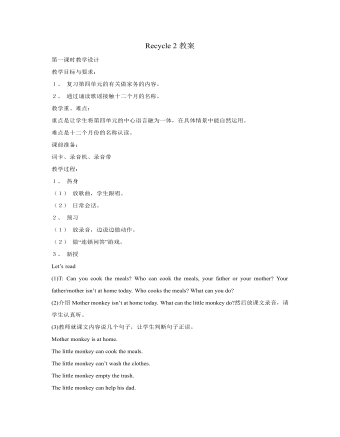
人教版新课标PEP小学英语五年级上册Recycle2教案
教学目标与要求:1、 通过活动和复习句型,介绍及动作短语等。2、 学唱歌曲。教学重、难点:重点为复习巩固介词及存在句型。难点为正确区分内容相近的图片。课前准备:词卡、录音机、录音带、图片教学过程:1、 热身(1) 放歌曲录音,学生跟唱。(2) 师生进行日常会话。2、 预习做“按我说的做”游戏。3、 新授(1) 看图片,问:Where is the …? Ss: It’s in /on/over…(2) 做“猜一猜”游戏。(3) 两人一组完成Pair work,连一连,说一说。(4) 听录音,完成练习。录音原文如下:There are mountains behind her village. There is a river near her house. There is a new air-conditioner in her bedroom. She cleans her bedroom every day.There is a lake near his village. There are many trees in front of his house. There is a big trash bin in his kitchen. He can cook tasty meals.There is a forest near his village. There is a road beside his house. There is a man under a tree. He often waters the flowers.There are many Paths in her village. There are new curtains on the window of her house. There are many new skirts in her closet. She washes the clothes every weekend.巩固延伸:做“幸运摸奖”游戏
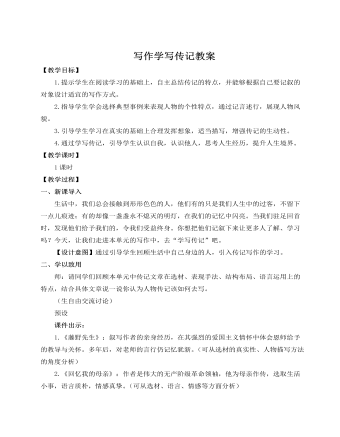
人教部编版语文八年级上册写作学写传记教案
在我到了入学年龄时,父亲为了我能够受到更好的教育,又将我和弟弟接回温州,我开始了我的读书生涯,父亲也开始了他全新的创业史。2015年,他当起了老板开始卖橱柜。为了使自己的橱柜能够做得更好,他到处去学习,读书上课都成了他的日常。他注册了“九周橱柜”的商标,做了极富特色的Logo,将“高雅品质,好而不贵”八个字定为自己企业的宣传口号。四年时间,他日思夜想的,都是如何将产品做得更加物美价廉。也正是因为他的执着与专注,他的企业很快从一家门店扩展到了五家门店,为温州千家万户安装上了崭新的橱柜。父亲今年35岁,他的身上总散发着一种向上的力量,吸引着周围的人同他一起进步。他说自己正当奋斗努力的时候,还需要不断进步。再过十年,我给他写的小传会更为精彩。我也拭目以待。
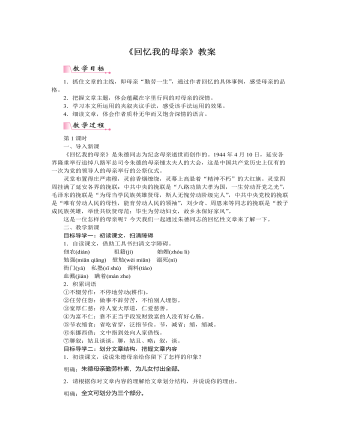
部编版语文八年级上册《回忆我的母亲》教案
这一句议论,呼应前文的记叙——母亲教“我”生产的知识,同情革命、支持革命,让“我”养成革命的意志。这些都是“我”感谢母亲的重要原因。“母亲是一个平凡的人,她只是中国千百万劳动人民中的一员,但是,正是这千百万人创造了和创造着中国的历史。”母亲勤苦一生,任劳任怨,反抗地主豪绅的欺压,坚强不屈,母亲就是一位普普通通的农妇,她是“平凡的”,但正是像母亲这样的千百万劳动人民,融汇成革命的洪流,推动着历史的发展,为我们的民族做出了不可磨灭的贡献,中国的现在、未来都将是劳动人民的。这句议论,将对母亲的深情与对民族、对广大劳动人民的深情融汇在一起。
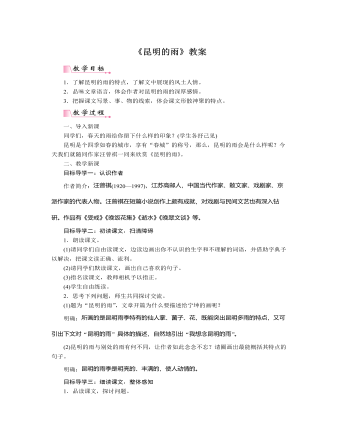
部编版语文八年级上册《昆明的雨》教案
2.思考下列问题,师生共同探讨交流。(1)题为“昆明的雨”,文章开篇为什么要描述给宁坤的画呢?明确:所画的是昆明雨季特有的仙人掌、菌子、花,既能突出昆明多雨的特点,又可引出下文对“昆明的雨”具体的描述,自然地引出“我想念昆明的雨”。(2)昆明的雨与别处的雨有何不同,让作者如此念念不忘?请圈画出最能概括其特点的句子。明确:昆明的雨季是明亮的、丰满的,使人动情的。目标导学三:细读课文,整体感知1.品读课文,探讨问题。(1)这样明亮又丰满的雨季自然是使人动情的。你体会到作者怎样的情感?明确:怀念、喜爱、乡愁。(2)你是从文中哪些词句之中体会出作者的这种感情的?明确:结合具体的写雨、物、人等的句子,让学生理解作者想念的不仅仅是“雨”,还有物、景、人、事,想念的是昆明的民风、人情和当年在那里的宁静、恬然的生活。





















